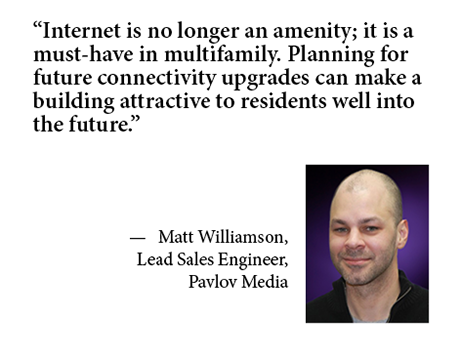In the rapidly evolving landscape of multifamily technology, owners and operators face a critical challenge to staying competitive. As demand for high-speed internet and robust connectivity grows, it is essential to adapt quickly. However, constantly upgrading infrastructure can be prohibitively expensive and time-consuming.
The solution lies in future-proofing properties — building an adaptable infrastructure that can support unknown future technological needs.
“Future-proofing is a matter of having infrastructure capable of supporting what we don’t know we will want later,” says Matt Williamson, lead sales engineer at Pavlov Media, which provides Wi-Fi, fiber-optic internet service and managed digital services to multifamily properties.
Future-proofing involves implementing scalable and flexible communication systems that accommodate both current and emerging digital demands. By focusing on future-proofing, multifamily properties can meet residents’ increasing expectations for high-speed internet and comprehensive Wi-Fi coverage while also reducing operational costs and enhancing overall efficiency.
Balance Current Needs with Future Trends
“Multifamily residents now expect extremely high-speed internet connections in their units and throughout the entire property, including common areas like gyms, conference rooms, pools and walking paths,” Williamson says.
Residents want robust internet connections for activities such as streaming, video calls and remote home monitoring. The importance of upload speeds is increasing due to data-intensive activities like video conferencing, e-learning and social media.
Additionally, property operators are leveraging new technologies and monitoring systems to interact more efficiently with residents, reduce energy consumption, automate maintenance and manage risks with remote alerts.
Engaging with residents through surveys or conversations can provide valuable insights into their needs and preferences, guiding future infrastructure improvements, Williamson explains. To support data-heavy applications, infrastructure upgrades are necessary and expert advice is crucial for making informed decisions about network demands and enhancements.
A Building’s Infrastructure as Potential Internet Bottleneck
The communications infrastructure present already in multifamily properties — cabling, Wi-Fi access points, network hardware and fiber optic lines — determines how hard it is for each building to enable and support future technological leaps. These leaps require faster speeds and more data but do not always require drastic overhauls and renovation.
“Future-proofing makes sure your communications from point A to point B will let you bolt on whatever software or hardware you will eventually need to provide services in the future,” says Williamson.
Many buildings are approaching a technological roadblock: the end of easily upgradable internet connectivity.
Is it better to renovate and add more cabling in the walls or add Wi-Fi access points throughout the rest of the property? The answer depends on the type of building in question. Future-proofing provides a realistic way for multifamily owners and operators to make cost considerations today and a path for them to set up systems that will create savings into the future.
New construction. New construction allows multifamily properties to install the fastest fiber optic infrastructure available easily because the proper materials can be placed in the walls during construction. There is no need to open walls to redo work, but owners and operators may want to take steps now to allow for easy future upgrades. These steps may include adding higher bandwidth fiber optics cables, advanced or upgradable routers or better cable systems.
Existing buildings. Existing buildings, whether conversions or renovations, may have adequate infrastructure if they are relatively recent. Structures built or last updated in the late 1990s or early 2000s likely feature copper-based cabling. This outdated technology is insufficient for current data demands and will require significant upgrades to support modern infrastructure needs.
A middle ground might be possible: upgrade cabling that powers critical wireless access points. Meanwhile, leave in place older wiring dedicated to slower resources (such as printers) that do not need extra connection speed.
Anticipating Costs
To anticipate costs and future-proof their buildings, multifamily owners and operators need to focus on strategic investments and thorough financial planning. One essential aspect is the installation of robust infrastructure such as fiber optics, conduits and microducts, which provide the necessary options for future technological upgrades. Implementing these systems during initial construction or major renovations can significantly reduce future costs and disruptions.
There are two major tools owners can use to control and moderate expenses. One is to make advanced strategic decisions. “It generally comes down to how you want to position your property compared to the other properties around you,” says Williamson. “Internet is no longer an amenity; it is a must-have in multifamily. Planning for future connectivity upgrades can make a building attractive to residents well into the future.”
For instance, having conduits in place allows for easy and inexpensive upgrades by simply pulling new cables through existing pathways, rather than tearing down walls and undertaking costly repairs later. “It can be fairly painless if somebody has done the due diligence, knows what the property looks like and understands the infrastructure,” Williamson adds.
The other tool is commissioning a service provider to perform a thorough site survey. Experts can test and review the physical and electronic characteristics of the entire property. By the end, they will know what is critical to ensuring the desired service for today and what might be necessary for the next 10 to 15 years as technology changes. The investment allows infrastructure design and strategy to be as cost-effective as possible.
Perform proper due diligence to find out what residents want, consider how to position the property against competitors and use a site survey to identify what the infrastructure requires not just for today but the next few decades. This approach offers the best route to get what is needed, control costs and minimize surprises.
— By Erik Sherman and Sarah Daniels. This article was written in conjunction with Pavlov Media, a content partner of REBusinessOnline. For more information on Pavlov Media, click here.


